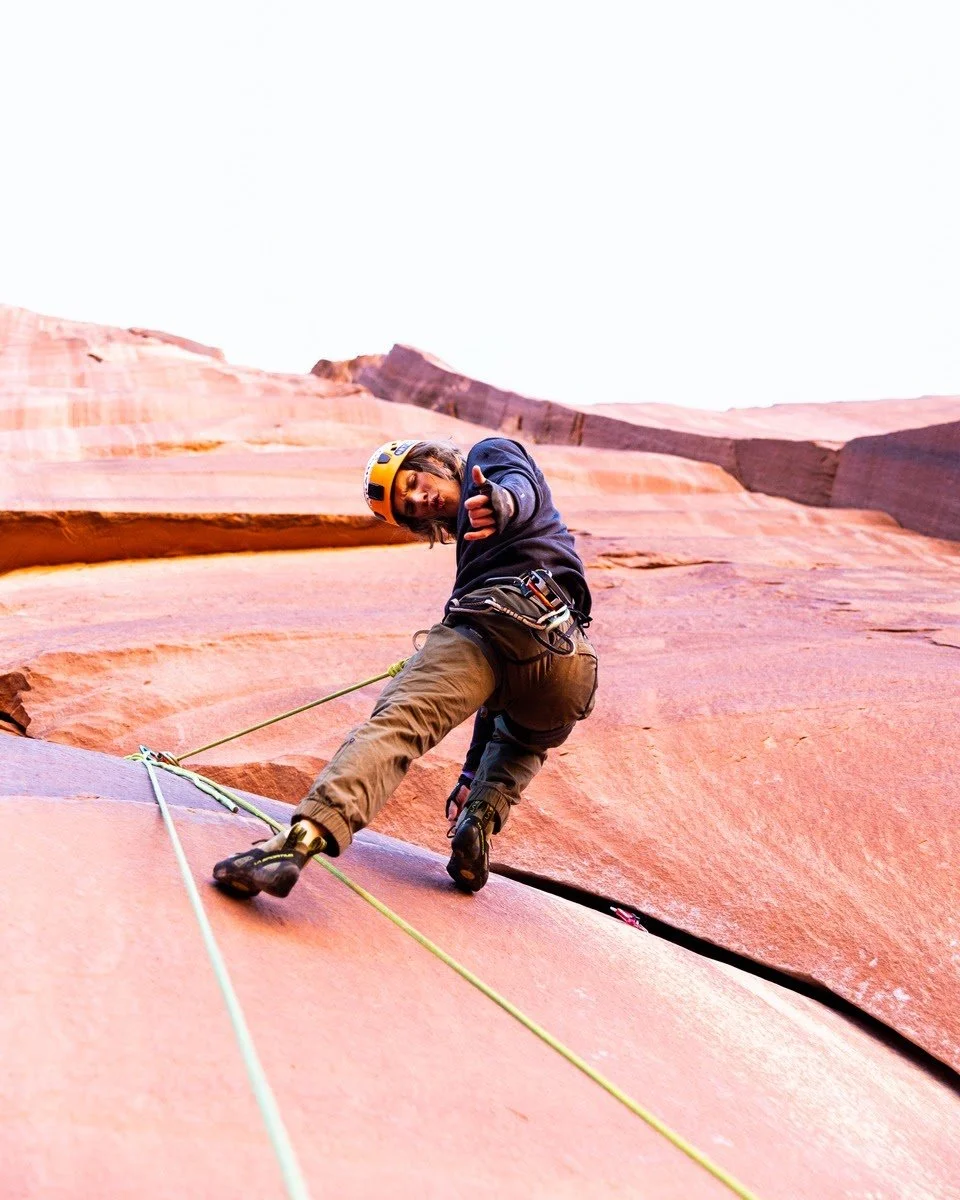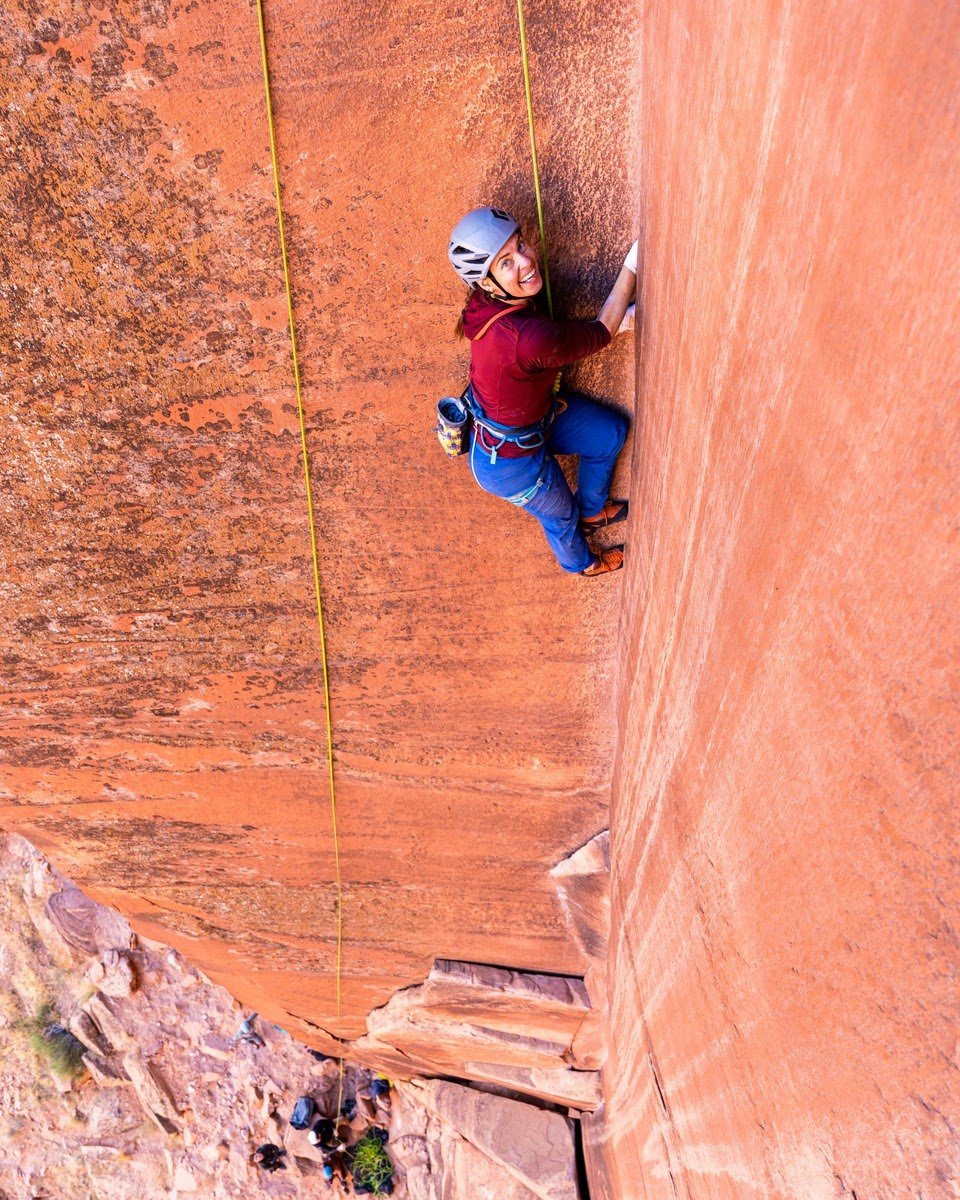
Warriors Way
Falling & COMMITMENT Clinic: Moab
Single:$275
Intermediate
Moab, Utah
1-Day
Growth, Mindset, Passion. Are you ready to deep-dive into the sport climbers’ mindset with expert coaching from Sevve Stember?
This clinic will take place in the gorgeous and scenic Colorado River corridor, near Hwy 128, at Take Out Beach. Positioned above the river, you'll have amazing views of the river valley while climbing on engaging sandstone sport climbs.
For more information on Warrior's Way Falling and Commitment Clinics.

-
Learn How To:
● Become aware of your mind’s limiting tendencies (like thinking you’ll clip the chains)
● Distinguish between no-fall and yes-fall zones
● Rest efficiently to avoid the pump
● Develop flow and momentum to make climbing easier
● Deal with mental stress before, during, and after the climb
● Improve problem-solving skills for better route finding and beta sequences
● Make and stick to appropriate risk decisions
● Use your intelligence to do effective risk-assessment
● Reduce fear when pushing yourself
● Make climbing more fun
-
During the Pennsylvanian Period (320-285 million years ago), much of Utah was covered by ocean. A small arm of the Ancestral Rockies penetrated into Utah from the east, north of the Moab area. Extending south from the tip of these highlands was an area that was occasionally submerged, occasionally "high and dry." The Moab region was a gigantic deep "sinkhole," called the Paradox Basin.
From time to time, the Paradox Basin would be flooded with ocean water as sea levels rose (or the land bridge subsided). A layer of limestone would form in this new ocean bay. Then the Paradox Basin would be cut off from the ocean and would dry out, leaving evaporated salts, capped with shale. Multiple such cycles occurred over millions of years, leaving over 1000 feet of salt. No rock of the Pennsylvanian Period is exposed at the surface in the Moab area, but the shape of the land has been affected by the Paradox Formation salt (more on this later).
Potash (a salt of potassium) is mined from Paradox Formation deposits deep under the Colorado River. The plant can be seen from here at the overlook at the end of the Amassa Back trail.
-
Ingalls was especially enthralled with Castleton and Fisher Towers, but he lacked the partner to climb them with. In 1959, he met Layton Kor. “There was an immediate rapport between us, and the next day we climbed the Bastille Crack in Eldorado Canyon,” Ingalls wrote in 1989. “I was amazed, even shocked by his ability. Here was the man for Castleton Tower.”
In, 1961 they explored the base of Castleton Tower. After finding a good line on the southeast face, later known as the Kor- Ingalls Route, Kor was off leading the pitches. The rock turned out to be delightfully solid, composed of Wingate Sandstone. The climb went smoothly until a storm gathered on the descent. Kor rappelled to the ground safely, but Ingalls was struck by a lightning ground shock through the rope. He was shaken, but unhurt.
Such storms can be fairly common on Castleton, but amazingly, after thousand of ascents, the only fatality on Castleton occurred from a lightning strike in 2005.
Typical of the style of many first ascents in the desert of Utah, the endeavor was a bold and dangerous undertaking, rife with adventure. Not to mention obscurity.
Besides Kor and Ingalls, there were several other climbers making a name for themselves in the desert. One of them was Harvey Carter, a skilled climber from Colorado Springs. He had an affinity for sandstone, especially since Garden of the Gods was his home stomping grounds. Credited with climbing 40 new towers, including the Priest in 1962 with Kor and Fred Beckey, Carter climbed several first ascents with Kor and Ingalls. But he missed out on Castleton, as well as Standing Rock.
Typical of the style of many first ascents in the desert of Utah, the endeavor was a bold and dangerous undertaking, rife with adventure.

-
FOOTWEAR
+Socks
UPPER LAYERS
+Synthetic T-shirt
For Colder Days Please Consider
BOTTOM LAYERS
GLOVES/HATS
+Buff
BACKPACKS
+15-20L Climbing Backpack
+35-55L Crag Pack
ACCESSORIES
+Sunglasses, Sunscreen, Lip Balm, Sun Hat
+Nalgene, Minimum 1.5L
+Climbing Snacks: 100 calories an hour!
EQUIPMENT
+Belay Device w/Locking Carabiner
+3 Additional Locking Carabiners
+120cm Sewn Sling w/ Non-Locker
+Autoblock Cord w/ Non-Locker
Smile Mountain Guides can supply rock climbing gear including helmets, harnesses, shoes, ropes, cams, slings, carabiners, belay/rappel devices.
-
AIR TRAVEL
There are regular flights to Salt Lake City, Denver, and Grand Junction.
Two flights arrive in Moab from Salt Lake City, UT on Delta/Skywest Moab Airport.
We suggest making your reservation as soon as possible as these flights fill up quickly.
If flights are sold out, your options include flying into Grand Junction- GJ Airport, Salt Lake City- SLC Airport, or Denver- DIA Airport and renting a car.
Grand Junction is the closest option, just two hours away. Salt Lake City is next at four hours and Denver is five and a half hours drive from Moab.
-
Guests will stay at Red Moon Lodge and Retreat in Moab, Utah.
PREPARATIONS FOR WARRIORS WAY MOAB
Technical Experience
Able to sport climb 5.9 in a gym with no falls. Climb indoors/outdoors at least 1-2 times per week, and at least 9 months of continuous climbing experience within the last year
Fitness
Moderate physical fitness is strongly recommended. Climbers should be able to hike and climb for approximately 6-8 hours while carrying a small pack.
Meet Your Instructor
FAQ’s
Warriors WAY MOAB QUESTIONS
The answers to our most commonly asked questions for WW Moab.
-
PRICE INCLUDES
+Instructor fees (6:1 climber-to-guide ratio)
+Group equipment such as ropes, helmets, harnesses, shoes, and technical climbing equipment.
PRICE DOES NOT INCLUDE
+Personal equipment (see Gear List)
+Transportation
+Hotels/lodging in Moab
+All expenses incurred in the event of early departure (evac fees)
+Trip cancellation insurance
-
Smile Mountain Guides provides the following gear.
Technical:
+Helmets
+Harness
+Shoes
+Small backpack
+Ropes and group technical equipment
Smile Mountain Guides does not provide the clothing needed to be comfortable in the mountain environment.
-
Warriors Way Clinics in Moab are instructed at 6:1
-
Please click here to review our domestic cancellation policy.
-
Unfortunately, no.
A large portion of our business is designed around custom adventures. Please email, climb@smilemountainguides.com if you would like more information.










